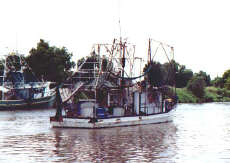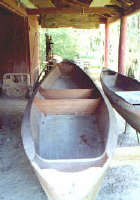 |
|
On your way outta the Big Easy, stop off for some Cajun fast food. As it says on the sign, you can buy fresh oysters ($3.50 for 2 gallons!), shrimp and crabs here. |
![]()
Cajun Country
You may as well be in another country, because the Cajuns have about as much to do with mainstream America as the Dogon people of Mali. In small towns with titles such as “Frog Capital of the World” and “Tree City, USA”, old men play homemade accordions under cypress trees in the swamp, singing in a strange French dialect about things like boucherie. That’s a Cajun word for the communal butchering of a pig.
There is no other place in the United States where one ethnic group influences the entire state but can’t be found in significant numbers anywhere else. In the 1990 census, 10 percent of the state’s population (about 400,000) listed Cajun or Acadian as their first ancestry, but nearly the entire state was influenced by the Cajun culture in one way or another. “Cajun” is not just a food or music – it is a way of life – and its influence in Louisiana has been like no other.
Cajuns invoke a lifestyle started more than two centuries ago by the 3,000 French-speaking Catholics who settled the area in 1764, after being forced out of their homelands in what is now Nova Scotia. Many of the elders have skins like leather, toughened after years in the swamps, living lives of hunting and fishing with routines that have gone unchanged for decades.
There has been a recent burst of cultural pride among the Cajuns. The cooking remains popular as ever and the music still fills the dance halls, but many ask whether it is merely a fad with the younger generations or a true rebirth. But the fact remains that many traditional customs and the Cajun dialect of French has been disappearing with time, perhaps heading for extinction within a generation.
 |
|
A shrimp boat on the bayou. |
![]()
In the 1980s, when Chef Paul Proudeome made Cajun nationally popular by accidentally burning red fish (Blackened Redfish), everyone wanted everything that was Cajun. Not only was Cajun food popular, so was the music. Formed in 1976 by fiddle player Michael Doucet, Beausoleil helped spread Cajun music around the country. He appeared on talk shows, performed at Carnegie Hall, and even popped up on MTV and Showtime. From New York to Los Angeles, it was actually becoming cool to be Cajun.
This new interest in everything that was Cajun helped form an economic alternative in Louisiana, in the form of cultural tourism. The people of Acadiana soon realized that people wanted to pay to eat, drink, and dance their way across Louisiana. For more than 200 years Cajuns had quietly passed down their culture from generation to generation with little knowledge or care of what outsiders thought of them. Suddenly, they had become celebrities.
Yet, most Cajun fans didn’t realize that the culture they were celebrating was dying back in Acadiana after almost a century of ridicule, ostracism, and a push to conform to modern ways.
The destruction of the Cajun customs and dialect started in the 1920s, when the illiterate Cajun population was forced to send its children to schools where they were banned from speaking French. Many of the Cajun men who were shipped off to World War II returned “Americans”, having less respect for their native culture, which was taught to them to be inferior. By the 1950s, a booming local oil industry pulled many men away from fishing and farming in search of steady work. The Cajun population was further diluted by an influx of workers from Texas and Arkansas, and as the television arrived, Cajun Country was becoming more Americanized than ever. During the 60s and 70s efforts to revive the French language only backfired, when teachers who were brought in from other countries taught that the local language was inferior. The number of people in Louisiana that spoke French at home dropped by more than half between 1970 and 1980.
There are the Cajun names such as Angelle, Thibodeaux, Hebert, and Guillot that are heard constantly throughout Southern Louisiana. In Lafayette, the Landry Family reunion drew more than 1,000 guests. It’s the little specks on the map like Carencro, Ville Platte, Lake Fausse Point, Holly Beach, and Butte la Rose where the Landrys are found, doing things like artist George Rodrigue depicted in his paintings of traditional Cajun culture.
 |
|
A “pirogue”, or homemade canoe, also known as a “Cajun cadilac”. Anyone who lives near water in Louisiana has a pirogue. |
![]()
The common stereotype of Cajuns is that they are crude, ignorant hillbillies who speak broken English with French accents. In 1999 when Adam Sandler played the stereotype of an ignorant Cajun in The Water Boy, Acadiana wasn’t laughing. The word “coonass” is something that you’ll hear a lot in Cajun country. While most Cajuns use it as a mild-mannered term of endearment for their heritage, there are a few who consider it the ultimate ethnic slur. Its origin is often believed to be from the Caribee Indian word cunaso, simply meaning someone who lives off the land, and you’ll see quite a few stickers on trucks saying “RCA, Registered Coon Ass”. In the end, Cajuns act as many ethnic groups in that it’s okay to make fun of them if you are one of them. Spend any amount of time in Cajun country, and you’ll hear plenty “Boudreaux and Thibodeaux” jokes.
But no matter what people think of them, Cajuns always get the last laugh when it comes to beauty: 4 Cajun women have been finalists in the “Miss USA” pageant. Ali Landry, former ULL student and Breaux Bridge native, went on to win the pageant in 1996, showing the world that not all Cajuns had scruffy beards and missing teeth.
Today, Cajuns aren’t so much found making moonshine in the swamps or chasing gators at night with large knives. You find them in places like Fred’s Lounge in Mamou or at the Liberty Theater in Eunice, doing what it is so many of them love to do: dance. You’ll find them at the weekly festivals in Acadiana, such as the World Championship Etoufee Cookoff or the “Super Boot Scootin’ Frontier Day in Crowley”, cooking gumbos and drinking cold beer. While some may still live under moss-covered oak trees near murky bayous in wood-planked cabins, most of them live in Lafayette and its small surrounding quiet towns. It’s not the spicy gumbos, swamp tours, or alligators that leave impressions with the visitors.
It’s the people.